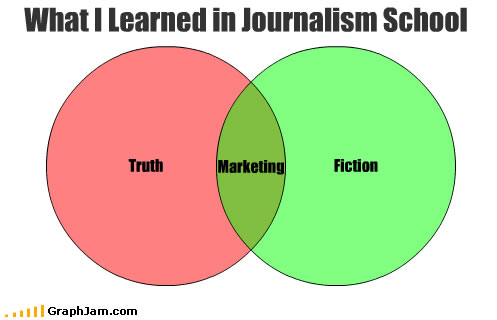Quite obviously the dark days of the old school broadcast mentality are dead and gone. Good Riddance.
And we all know social media is empowering public relations and marketing professionals to have conversations directly with the publics that define and matter most to the brands they represent. But one of the most attractive and inspiring aspects of social media is that people with common interests, professions and goals now, and with a robust sense of community, can easily share info, tips, trends, questions and solutions surrounding best practices or they can simply just listen to the collective from the comfort of their own homes – but in the age of transparency and participation this is not always recommended.
These days, it’s all about utilitarian information, conversations, niches, communities, stories and the value that each possess and can bring to someone else. A perfect example of people utilizing social media to assemble and virtually interact amongst themselves for the purposes and betterment of all of those things I just mentioned above is the live Twitter Chat.
Twitter Chats are group conversations on Twitter centered around a distinct topic or issue, for example, “financial well-being for nonprofit employes.” Chats are usually steered by a moderator or guest host and the larger ones can have general rules in place to foster seamless and polite talk. These conversations, which can include hundreds of people, are conveniently organized around and searchable by tweets with a common hashtag (e.g.#foodchat).
There are also web-based applications that can be used to track and participate in these live and spirited conversations, but what I will concentrate on here are a few of the most salient weekly Twitter Chats that are a must for those of us looking to break into public relations, learn to ethically and effectively apply the tactics and strategies used everyday to drive action and get results and harness the digital evolution which is blazing forward at incredible speeds. A caveat; As I write this post, I myself am still learning about and exploring these Twitter Chats and will therefore be embarking on the journey with you – so look for me out there in the Twitterverse!
Live Twitter Chats for PR Pros
 1. #CommsChat: This UK-based Chat is cofounded and produced by Adam Vincenziniand Emily Cagleand goes live on Mondays starting at 8:00 pm UK time, which is 3:00 pm EST for us on the east coast. These conversations are based around “all aspects relating to communications including PR, traditional & social media, journalism, blogging, marketing and more.” What makes this a must for us is that knowledgable pros, from varying communications disciplines, participate in and share their experiences and opinions with the community. Social and New Media have blurred the lines between these disciplines and have made integrated and collaborative campaigns essential, so this Chat rocks. Check it out.
1. #CommsChat: This UK-based Chat is cofounded and produced by Adam Vincenziniand Emily Cagleand goes live on Mondays starting at 8:00 pm UK time, which is 3:00 pm EST for us on the east coast. These conversations are based around “all aspects relating to communications including PR, traditional & social media, journalism, blogging, marketing and more.” What makes this a must for us is that knowledgable pros, from varying communications disciplines, participate in and share their experiences and opinions with the community. Social and New Media have blurred the lines between these disciplines and have made integrated and collaborative campaigns essential, so this Chat rocks. Check it out.
 2. #blogchat: This weekly conversation takes place on Sunday nights at 8:00 pm Central, which is 9:00 pm EST. The host of the Chat is Mark Collier, a social media consultant, speaker and trainer. Each week a different blogging topic is chosen, with Chats covering such topics as “how to optimize your blog for search engines” and “how a company can pick its blogging team.” The value inherent in this Chat is quite obvious – blogging, whether personally or for business is an easy and effective way to establish thought leadership. Create awesome content that also solves people’s problems or gives them value in some way and get noticed by the world – whether your goal is to get noticed by prospective employers or by consumers. It is one of the most important topics for us as young communicators.
2. #blogchat: This weekly conversation takes place on Sunday nights at 8:00 pm Central, which is 9:00 pm EST. The host of the Chat is Mark Collier, a social media consultant, speaker and trainer. Each week a different blogging topic is chosen, with Chats covering such topics as “how to optimize your blog for search engines” and “how a company can pick its blogging team.” The value inherent in this Chat is quite obvious – blogging, whether personally or for business is an easy and effective way to establish thought leadership. Create awesome content that also solves people’s problems or gives them value in some way and get noticed by the world – whether your goal is to get noticed by prospective employers or by consumers. It is one of the most important topics for us as young communicators.
 3. #journchat: Hosted by Sara Evans, this Twitter Chat between journalists, PR professionals and bloggers goes live Monday nights from 7:00-10:00 pm CT, which is 8:00-11:00 pm EST. Concerning the ethos behind the Chat Evans writes, “I believe there is a need in this evolving world of media and public relations for some major dialogue between those who make it happen.” This is one of the best and most dynamic Chats around, and we should certainly be participating in it because the folks having the conversations comprise the very influencers, we as PR pros, should be familiar with and knowledgable about.
3. #journchat: Hosted by Sara Evans, this Twitter Chat between journalists, PR professionals and bloggers goes live Monday nights from 7:00-10:00 pm CT, which is 8:00-11:00 pm EST. Concerning the ethos behind the Chat Evans writes, “I believe there is a need in this evolving world of media and public relations for some major dialogue between those who make it happen.” This is one of the best and most dynamic Chats around, and we should certainly be participating in it because the folks having the conversations comprise the very influencers, we as PR pros, should be familiar with and knowledgable about.
 4. #pr20chat: Weekly Tuesday Chat about Public Relations 2.0 at 8:00-9:00 pm EST. This conversation is moderated by @PRtini and @JGoldsborough. I included this Chat on the list because its community’s focus is on “how social media influences PR professionals’ engagement with ALL publics (not just the media and bloggers).” This Chat, combined with #journchat should give some insightful ideas on the strengthening of relationships and engagement with all the stakeholders we are expected to reach and interact with, genuinely and effectively. Here’s a recent transcript of the Chat to check out for yourself.
4. #pr20chat: Weekly Tuesday Chat about Public Relations 2.0 at 8:00-9:00 pm EST. This conversation is moderated by @PRtini and @JGoldsborough. I included this Chat on the list because its community’s focus is on “how social media influences PR professionals’ engagement with ALL publics (not just the media and bloggers).” This Chat, combined with #journchat should give some insightful ideas on the strengthening of relationships and engagement with all the stakeholders we are expected to reach and interact with, genuinely and effectively. Here’s a recent transcript of the Chat to check out for yourself.
 5. #socialmedia: This Chat is serious. The guys behind this weekly Chat, live every Tuesday from 12:00-1:00 pm EST, are Jason Breed and Marc Meyer. In the interest of space their bios are here. The Chat hosts “Leaders of Fortune class companies as moderators and participants to share, moderate and challenge this group to come up with industry specific best practices, new concepts, etc. related to #socialmedia.”
5. #socialmedia: This Chat is serious. The guys behind this weekly Chat, live every Tuesday from 12:00-1:00 pm EST, are Jason Breed and Marc Meyer. In the interest of space their bios are here. The Chat hosts “Leaders of Fortune class companies as moderators and participants to share, moderate and challenge this group to come up with industry specific best practices, new concepts, etc. related to #socialmedia.”
What makes this Chat a must is that the topics covered on a weekly basis are among the most challenging but interesting and definitely critical for us as communicators. For example, on June 22nd the Chat featured Shel Holtz who guided conversation on The New Digital Press Release. Also, check out their site to stay up on special events and the specific hashtags to follow for them (e.g. #sm65).
Let me know in the comments section if there any other conversations that we, as young, driven communicators should know about.
Thanks.






